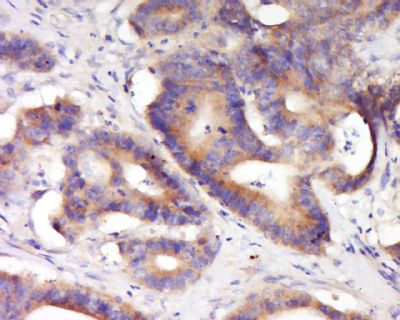产品货号 : mlR16921
英文名称 : KCNV2
中文名称 : 电压门控钾通道Kv8.2抗体
别 名 : KCNV2; KCNV2_HUMAN; KV11.1; Kv8.2; MGC120515; Potassium channel subfamily V member 2; Potassium voltage-gated channel subfamily V member 2; RCD3B; Voltage-gated potassium channel Kv8.2; Voltage-gated potassium channel subunit Kv8.2.
研究领域 : 细胞生物 神经生物学 通道蛋白
抗体来源 : Rabbit
克隆类型 : Polyclonal
交叉反应 : Human, Mouse, Rat, Chicken, Dog, Pig, Cow, Horse, Rabbit,
产品应用 : ELISA=1:500-1000 IHC-P=1:400-800 IHC-F=1:400-800 Flow-Cyt=2μg/Test ICC=1:100-500 IF=1:100-500 (石蜡切片需做抗原修复)
not yet tested in other applications.
optimal dilutions/concentrations should be determined by the end user.
分 子 量 : 62kDa
细胞定位 : 细胞膜
性 状 : Lyophilized or Liquid
浓 度 : 1mg/ml
免 疫 原 : KLH conjugated synthetic peptide derived from human KCNV2:131-230/545 <Extracellular>
亚 型 : IgG
纯化方法 : affinity purified by Protein A
储 存 液 : 0.01M TBS(pH7.4) with 1% BSA, 0.03% Proclin300 and 50% Glycerol.
保存条件 : Store at -20 °C for one year. Avoid repeated freeze/thaw cycles. The lyophilized antibody is stable at room temperature for at least one month and for greater than a year when kept at -20°C. When reconstituted in sterile pH 7.4 0.01M PBS or diluent of antibody the antibody is stable for at least two weeks at 2-4 °C.
PubMed : PubMed
产品介绍 : Voltage-gated potassium (Kv) channels represent the most complex class of voltage-gated ion channels from both functional and structural standpoints. Their diverse functions include regulating neurotransmitter release, heart rate, insulin secretion, neuronal excitability, epithelial electrolyte transport, smooth muscle contraction, and cell volume. This gene encodes a member of the potassium voltage-gated channel subfamily V. This member is identified as a 'silent subunit', and it does not form homomultimers, but forms heteromultimers with several other subfamily members. Through obligatory heteromerization, it exerts a function-altering effect on other potassium channel subunits. This protein is strongly expressed in pancreas and has a weaker expression in several other tissues. [provided by RefSeq, Jul 2008]
Function:
Potassium channel subunit. Modulates channel activity by shifting the threshold and the half-maximal activation to more negative values.
Subunit:
Heteromultimer with KCNB1, KCNC1 and KCNF1. Does not form homomultimers.
Subcellular Location:
Cell membrane. Has to be associated with KCNB1 or possibly another partner to get inserted in the plasma membrane. Remains intracellular in the absence of KCNB1.
Tissue Specificity:
Detected in lung, liver, kidney, pancreas, spleen, thymus, prostate, testis, ovary and colon.
DISEASE:
Defects in KCNV2 are the cause of cone dystrophy retinal type 3B (RCD3B) [MIM:610356]; also called cone dystrophy with night blindness and supernormal rod responses KCNV2-related. RCD3B is a rare form of cone dystrophy associated with supernormal rod responses. The disorder is characterized by reduced visual acuity, photoaversion, night blindness, and abnormal color vision. At an early age, the retina shows subtle depigmentation at the macula and, later, more obvious areas of atrophy.
Similarity:
Belongs to the potassium channel family. V (TC 1.A.1.2) subfamily. Kv8.2/KCNV2 sub-subfamily.
SWISS:
Q8TDN2
Gene ID:
169522
Important Note:
This product as supplied is intended for research use only, not for use in human, therapeutic or diagnostic applications.
产品图片












